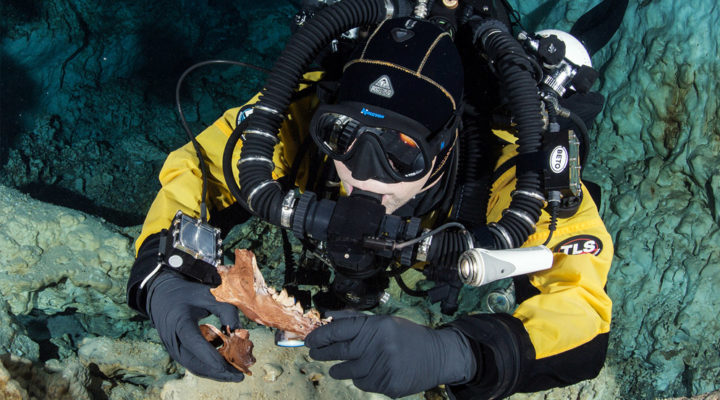EXACT AND NATURAL SCIENCES
Scientists found 15 thousand-year-old bear and wolf fossils in a submerged cave
The discovery, which took place Mexico, indicates that at some point South American fauna moved to the north. Two CONICET researchers identified the remains.
Arctotherium and Protocyon are bear and wolf genera that lived in South America and extinguished 10 thousand years ago. Their predecessors had emerged in North America much earlier and reached this part of the world during the phenomenon known as the Great American Biotic Exchange (GIBA), the migration of different species from one continental hemisphere to the other across the Isthmus of Panama when both masses of land finally joined, some three Myr ago.
Among other animals, gigantic carnivores arrived to this part of the world, settled without problems and reached even larger dimensions because they met a great variety of herbivore in the absence of predators. Experts used to believed that once these species established in the South, they had not moved back again, but the recent discovery of fossil remains dated between 12 and 38 thousand years old is a concrete proof that they did it. The study was published in Biology Letters.
“What’s the only possible explanation of this finding?” Leopoldo Soibelzon, one of the authors of the study wanders. He is a CONICET researcher at the CONICET en la Facultad de Ciencias Naturales y Museo de la Universidad Nacional de La Plata (FCNyM, UNLP). “We think at at a certain moment the environmental conditions of Central America and southern North America began to change and became favorable for some of these animal forms to cross over again. That must have happened a few thousand years before they went extinct.”
The ecological change that the scientist refers to would be the passage from tropical to pasture or savanna for that region of the planet. “This would confirm the hypothesis of the re-entry of the fauna that had been historically proposed based on the distribution of current carnivores”, explains Francisco Prevosti, CONICET researcher and director of the Regional Center for Scientific Research and Technology Transfer of La Rioja.
“The idea is that these lineages arrived in South America, evolved generating new genres and only some migrated to the center. At that time, the glacial was taking place- what is known as the Late Pleistocene- during which the sea level decreased a lot and allowed the environments of open vegetation to advance on the close ones such as forests. This could have encouraged the passage of the species we studied,” adds the specialist.
The information on environmental conditions is central because “in general, the fossil record of Central America and to a large extent that of northern South America is incomplete, specially in key periods of GIVA like this one”, Prevosti explains. Soibelzon, who studies great bears, adds: “In this case the materials were greatly preserved because they were in an intricate submarine cave that was favorable for conservation because there were no scavengers near or water movements to erode or move them.” The Argentine researchers affirm that the identification was simple because they were very complete.
Skulls, jaws and teeth of several specimens are the remains found fortuitously by professional divers who were exploring Hoyo Negro, a system of underground caves located in the north of Yucatán peninsula. The species of Arctotherium bears came to weigh a ton and to measure 4 and a half meters standing, while the dog sor wolves that belonged to the Protocyon genus hovered around 25 kilos. The discovery –paleontologists coincide- show that future research on those regions will probably change what is known about the biogeographic history of fossil mammals.
By Mercedes Benialgo
About the study:
Blaine W. Schubert. Teneessee State University. EEUU.
James C. Chatters. DirectAMS. EEUU.
Joaquin Arroyo-Cabrales. INAH. Mexico.
Joshua X. Samuels. Teneessee State University. EEUU.
Leopoldo H. Soibelzon. Independent researcher. FCNyM, UNLP.
Francisco J. Prevosti. Principal Researcher. CRILAR, CONICET- Gob. La Rioja- UNLAR- SEGEMAR- UNCA.
Christopher Widga. Teneessee State University. EEUU.
Alberto Nava. BAUE. EEUU.
Dominique Rissolo. University of California San Diego. EEUU.
Pilar Luna Erreguerena. INAH. México.
